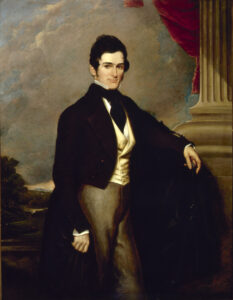George P. A. Healy
George P. A. Healy spent several seasons painting portraits in New Orleans during the 1840s and 1850s.

Courtesy of The Historic New Orleans Collection
James Robb. Healy, George A.P. (Artist)
F prolific and inventive artist, George Peter Alexander Healy is often cited as the finest American portraitist of his generation. Born on July 15, 1813 in Boston, Massachusetts, Healy became renowned for his artistic talent. He was acknowledged in Boston, Paris, London, and Chicago. Attracted by the vigorous market for portraiture in New Orleans, Healy spent several painting seasons (usually October through March) there during the 1840s and 1850s. He won a first-class medal for Franklin Presenting the Claims of the American Colonists before Louis VXI at the 1855 Paris International Exhibition — the highest French honor to that point accorded an American painter.
Gilbert Stuart’s daughter, Jane, lent Healy a print and provided an introduction to the famous portraitist Thomas Sully. Upon seeing an early effort by Healy, Sully is supposed to have said, “By all means, Mr. Healy, make painting your profession.” Without much further benefit of instruction, he opened a studio in his native Boston in 1831. On Sully’s advice, Healy traveled to Paris in 1834 with a subsidy from Mrs. Harrison Gray Otis, entering the studio of neoclassical painter Baron Antoine-Jean Gros. His academic training cut short by Gros’s suicide, Healy drifted around Europe for a few years. In France, Healy won a third-class medal at the Paris Salon in 1840 for a portrait of Mrs. Thomas Cass, wife of the U.S. Minister to France. The painting prompted King Louis Philippe to commission portraits of Lewis Cass, George Washington, and other U.S. statesmen. Healy then returned to the U.S. in 1842, visiting his home in Massachusetts before traveling down the Eastern seaboard.
The artist’s younger brother, Thomas Cantwell Healy (1820– 1873), may have been in New Orleans as early as 1841; both Healy brothers are documented the city by February 1843, having probably arrived some months earlier. Finding a lucrative market, Thomas maintained a regular winter studio for the next decade, and George visited again in 1844, 1845, 1849, 1851, 1855, 1857, and 1860. Healy seems to have visited the city a final time in 1867-1868. The World’s Industrial and Cotton Centennial (1884–1885) featured an exhibition of his paintings. Healy’s prices in 1860 ranged from $200 for Heads of Gentlemen to $1,000 for Grand size, Children the Same as Ladies.
Healy’s sitters represented elite members of society in Louisiana, as well as the ambitious, such as Didier Villars, a young receiving teller at the Commercial Bank, painted during Healy’s first residence. Following the style of Jean-Joseph Vaudechamp, Healy presented a rather somber head set against a plain, neoclassical background; still, the characterization is forceful and earnest. Healy’s larger paintings are often more dramatic, such as General Philemon Thomas (c. 1845), conveying at once domestic ease and monumentality. The three-quarter length James Robb (c. 1845) reinforces the businessman’s political and social power with a stormy sky, swag of drapery, and framing Doric column, visual conceits usually reserved for political or military leaders. Healy supported Robb’s ill-fated National Gallery in New Orleans, proposed in 1844, and based on the banker’s personal collection of Old Master paintings. Healy also catered to the emerging market for portraits of celebrities, such as Jenny Lind (ca. 1850). While his paintings of women are flattering, he often emphasized the sitter’s matronly aspects, such as in Portrait of the New Orleans Lady and Mary Conner Jurey (c. 1845).
Healy resided in Chicago from 1855 until 1867, in Paris and Rome from 1869 until 1892, and then returned to Chicago where he lived until his death in 1894. He traveled widely, copying paintings owned by Queen Victoria, spending time in Cuba, and working for the Queen of Romania.
Like John Wesley Jarvis and Matthew Jouett, Healy was a facile and accommodating portraitist, skilled at establishing rapport with his sitters. He was a tireless worker, completing about 3,000 portraits during his career. An outspoken abolitionist, he nevertheless accepted commissions from Confederate leaders such as General Pierre Gustave Toutant Beauregard, whom he painted at Fort Sumter, South Carolina, in late 1860. Healy is best known in the popular imagination for his many portraits of Abraham Lincoln, notably The Peacemakers (1865). He was not above petty jealousies, having few kind words for Gros or his confident in Paris, Thomas Couture. Describing himself as painfully shy, Healy was diplomatic and possessed of a keen wit. Once, when asked whether he preferred living in England or France, he replied, “In America.”
